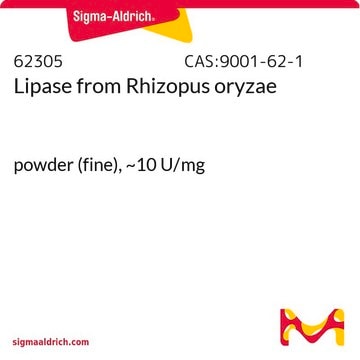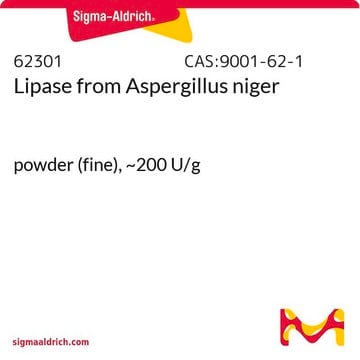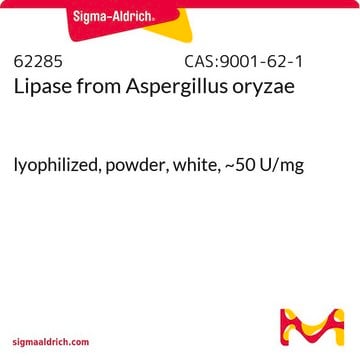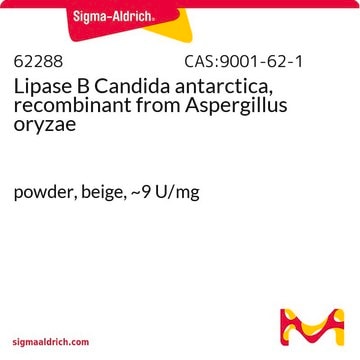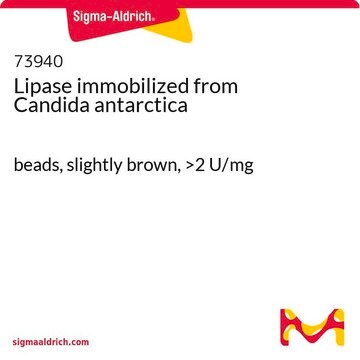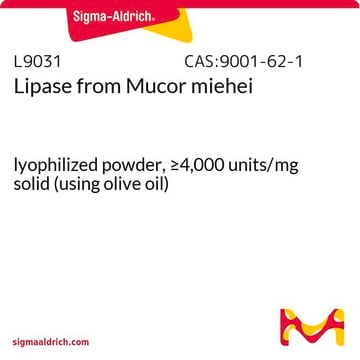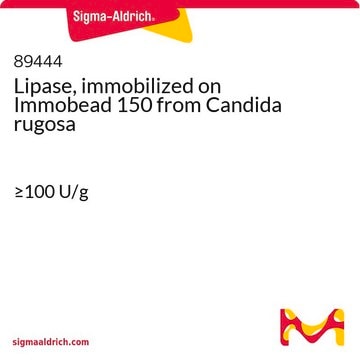80612
Lipase from Rhizopus oryzae
powder, light brown, ≥30 U/mg
Synonym(s):
Lipase F-AP 15
Sign Into View Organizational & Contract Pricing
All Photos(1)
About This Item
Recommended Products
biological source
fungus (Rhizopus oryzae)
form
powder
specific activity
≥30 U/mg
color
light brown
storage temp.
2-8°C
InChI
1S/C11H9N3O2.Na/c15-8-4-5-9(10(16)7-8)13-14-11-3-1-2-6-12-11;/h1-7,16H,(H,12,14);/q;+1/b13-9-;
InChI key
QWZUIMCIEOCSJF-CHHCPSLASA-N
General description
Research Area: CELL SIGNALING,Rhizopus oryzae lipase (ROL) is a protein synthesized in a precursor form that includes a 26-amino acid presequence, followed by a 97-amino acid prosequence attached to the N-terminal of a mature sequence consisting of 269 amino acids. ROL possesses four potential N-glycosylation sites and is characterized by nine α-helices and eight β-strands, resulting in a molecule stabilized by three disulfide bonds between residues 29–269, 40–43, and 235–244. Lipases are widely distributed in various living organisms, including animals, plants, and microbes.
Application
Lipase from Rhizopus oryzae has been used:
- to replace rabbit gastric extract for infant in vitro digestion
- in the two-phase lipase-catalyzed system for the enzymatic preparation of biodiesel
- in the simulation of infant gastrointestinal digestion in vitro, focusing on the characteristics of emulsions during digestion to replicate the stomach environment and adjust the emulsion pH
Biochem/physiol Actions
Lipases play a crucial role in catalyzing the breakdown of ester bonds of triglycerides at the interface between aqueous and oily layers. The lipase produced by Rhizopus species is known for its suitability in various industrial applications. In industrial settings, lipases of microbial origin are commonly extracellular and are produced during the fermentation process. The utilization of lipases has been shown to be more effective than traditional chemical syntheses in industries such as pharmaceuticals, cosmetics, oleochemicals, detergents, and fragrances.
These enzymes are widely used to modify the structure of oils and fats, tailoring natural lipids to meet specific properties useful for food, nutrition, and cosmetic applications. Lipases from filamentous fungi families, such as Rhizopus oryzae are extensively utilized in the oil and fats industry due to their high 1,3-regioselectivity toward triglycerides, making them versatile in lipid modification. Lipases are used industrially for the resolution of chiral compounds and the transesterification production of biodiesel.
These enzymes are widely used to modify the structure of oils and fats, tailoring natural lipids to meet specific properties useful for food, nutrition, and cosmetic applications. Lipases from filamentous fungi families, such as Rhizopus oryzae are extensively utilized in the oil and fats industry due to their high 1,3-regioselectivity toward triglycerides, making them versatile in lipid modification. Lipases are used industrially for the resolution of chiral compounds and the transesterification production of biodiesel.
Unit Definition
1 U corresponds to the amount of enzyme which releases 1 μmol fatty acid from triglycerides per minute at pH 7.2 and 37 C (olive oil as substrate)
Analysis Note
enzyme activity:
the optimum temperature is 40°C, the optimum pH is 7.2 (highly active from pH 6.5-7.5)
the optimum temperature is 40°C, the optimum pH is 7.2 (highly active from pH 6.5-7.5)
Signal Word
Danger
Hazard Statements
Precautionary Statements
Hazard Classifications
Resp. Sens. 1
Storage Class Code
11 - Combustible Solids
WGK
WGK 1
Flash Point(F)
Not applicable
Flash Point(C)
Not applicable
Personal Protective Equipment
dust mask type N95 (US), Eyeshields, Gloves
Certificates of Analysis (COA)
Search for Certificates of Analysis (COA) by entering the products Lot/Batch Number. Lot and Batch Numbers can be found on a product’s label following the words ‘Lot’ or ‘Batch’.
Already Own This Product?
Find documentation for the products that you have recently purchased in the Document Library.
Customers Also Viewed
Highly efficient enzymatic biodiesel production promoted by particle-induced emulsification
Mangas-S'anchez J and Adlercreutz P
Biotechnology for Biofuels (2015)
Changes in interfacial composition and structure of milk fat globules are crucial regulating lipid digestion in simulated in-vitro infant gastrointestinal digestion
Sun Y, et al.
Food Hydrocolloids, 134, 108003-108003 (2023)
Lipase from Rhizopus oryzae R1: in-depth characterization, immobilization, and evaluation in biodiesel production
Helal SE, et al.
Journal of Genetic Engineering and Biotechnology, 19(1), 1-1 (2021)
Production of Rhizopus oryzae lipase using optimized Yarrowia lipolytica expression system
Vidal L, et al.
FEMS Yeast Research, 23 (2023)
Lysine blockage of milk proteins in infant formula impairs overall protein digestibility and peptide release
Zenker HE, et al.
Food & Function, 358-369 (2020)
Our team of scientists has experience in all areas of research including Life Science, Material Science, Chemical Synthesis, Chromatography, Analytical and many others.
Contact Technical Service